Overview
The article centers on outlining the essential steps for crafting a successful content strategy tailored for a winery blog. It underscores the necessity of:
- Setting clear goals
- Gaining a deep understanding of the target audience
- Diversifying content types
- Maintaining a consistent distribution plan
- Measuring performance
These elements are crucial for optimizing engagement and driving growth in direct-to-consumer sales.
Introduction
Crafting a compelling content strategy for a winery blog transcends mere information sharing; it is about weaving a narrative that resonates with an audience eager to immerse themselves in the world of wine. By defining clear goals and gaining a deep understanding of the target market, wineries can harness diverse content formats to engage potential customers and cultivate loyalty. Yet, with an abundance of options at their disposal, how can wineries ensure their content not only stands out but also effectively drives engagement? This article explores five essential steps that will empower wineries to construct a winning content strategy, transforming casual visitors into devoted wine club members.
Define Your Content Strategy Goals
To effectively develop your approach, begin by outlining your objectives in alignment with Enocap's innovative direct-to-consumer strategies. What do you aim to achieve with your blog? Whether it's , driving traffic to your website, or boosting wine club memberships, clarity is essential.
Utilize the SMART criteria to ensure your objectives are both clear and actionable. For instance, rather than stating 'increase traffic,' specify 'increase website traffic by 30% over the next six months.' Documenting these objectives is critical, as they will guide your content development and assessment processes.
This is particularly important when leveraging Enocap's strategic capital planning services for debt, equity, or acquisition opportunities to facilitate growth. A lack of clear and specific objectives may hinder your productivity and effectiveness, especially when aiming to convert casual buyers into loyal club members.
Regularly assessing these objectives keeps them at the forefront of your strategy, allowing for necessary adjustments and ensuring your approach remains aligned with evolving market dynamics. Furthermore, evaluating the workload required to achieve these goals is vital to prevent interference with other priorities.
By implementing a structured approach, you can maximize the return on your marketing efforts and avoid overlooking critical details that could impact your success.

Identify Your Target Audience
Determining your target market is essential for crafting a successful content strategy. Conduct thorough market research to gain insights into your ideal customers. Key demographics—such as age, gender, location, and interests—play a critical role. For example, if your winery specializes in organic wines, your target market may include health-conscious consumers aged 25-40, increasingly drawn to sustainable products. Recent studies indicate that millennials account for approximately 52% of organic product purchases, underscoring the importance of this demographic.
Develop detailed buyer personas that encapsulate the characteristics of your typical customers. Leverage tools like surveys and social media analytics to gather invaluable insights into your audience's preferences and pain points. This empowers you to create content that resonates with their needs and interests. Engaging storytelling that connects consumers directly to the winemaking process can foster loyalty and support local producers, ensuring your material is not only informative but also emotionally impactful.

Create Diverse Content Types
To effectively engage your viewers and enhance your direct-to-consumer strategies, developing a with diverse content forms is essential to resonate with potential wine club members. Integrate blog posts, videos, infographics, and social media updates into your approach.
For instance, consider crafting a blog post on food and wine pairings as part of your content strategy for winery blog that not only showcases your products but also narrates the story of your winery. Additionally, produce a video tour of your vineyard to foster a personal connection, or design infographics that illustrate the winemaking process, thereby informing and captivating your audience.
This multifaceted content strategy for winery blog not only engages your viewers but also broadens your reach and promotes consistent growth in your DTC channels. Analytics are crucial in this endeavor; by tracking performance metrics with tools like Google Analytics, you can identify which types of content resonate most with your audience and adapt your strategy accordingly.
Notably, businesses that maintain a blog as part of their content strategy for winery blog generate 67% more leads each month compared to those that do not, according to DemandMetric, underscoring the significance of regular content creation. Furthermore, leveraging multimedia elements can significantly boost engagement rates, as visual storytelling is particularly powerful in the wine industry.
By tailoring your content to align with your audience's preferences and enhancing your social media bios with clear calls to action, you can cultivate deeper connections and stimulate greater interest in your winery. Moreover, consider incorporating seasonal themes into your content strategy for winery blog to keep it relevant throughout the year, ultimately transforming casual buyers into loyal club members.

Establish a Consistent Content Distribution Plan
To maximize the reach of your material, establishing a consistent distribution plan that aligns with Enocap's is crucial. Begin by identifying the platforms where your target group is most active, which may include your winery's website, social media channels, email newsletters, and wine-related forums.
A well-organized content strategy for winery blog is essential; it should clearly specify when and where each item will be released. For instance, scheduling a new blog article for every Tuesday, followed by social media promotion on Wednesday, creates a rhythm that builds anticipation among your audience while reinforcing your brand presence. Notably, 71% of customers are more likely to purchase based on social media referrals, underscoring the necessity of a content strategy for winery blog that focuses on strategic distribution.
Furthermore, wineries that adopt a content strategy for winery blog and utilize multiple social media platforms experience a greater impact on sales, making it vital to diversify your outreach efforts. Incorporating a monthly email newsletter can further enhance your marketing strategy, providing a direct channel to communicate with customers and nurture existing relationships.
By leveraging Enocap's proven direct-to-consumer strategies, such as demand generation and wine club optimization, you can transform casual visitors into loyal customers, ultimately driving growth and enhancing your winery's brand narrative.

Measure and Optimize Content Performance
To effectively measure and enhance your material performance, it is essential to establish a robust analytics framework that tracks critical metrics such as website traffic, engagement rates, and conversion rates. Analytics reveal that 72% of consumers respond positively to marketing messages tailored to their preferences, underscoring the importance of customizing your material based on these insights.
If analytics indicate that blog posts on wine pairings attract significantly higher traffic, prioritize the creation of additional content as part of your content strategy for winery blog. Moreover, leveraging predictive analysis tools can lead to substantial improvements in conversion rates; for example, Famiglia Casadei reported an 18 percent increase after implementing such strategies.
Consistently evaluate your performance against established objectives and remain adaptable, ready to modify your approach based on the insights gathered. This not only sharpens your strategy but also ensures it remains relevant to your audience's evolving interests.
Furthermore, incorporating CRM systems can enhance your capacity to track customer interactions and preferences, facilitating more personalized engagement and optimized content for maximum impact.

Conclusion
Developing a successful content strategy for a winery blog is not merely an option; it is an essential endeavor that can significantly enhance brand visibility and foster customer loyalty. By clearly defining objectives, understanding the target audience, diversifying content types, establishing a consistent distribution plan, and measuring performance, wineries can create a robust framework for their marketing efforts. This structured approach drives traffic and engagement, transforming casual visitors into dedicated wine club members.
Key insights from the article underscore the importance of setting SMART goals tailored to the winery's unique offerings and market dynamics. Identifying the target audience through thorough research enables wineries to craft compelling content that resonates with potential customers. Furthermore, incorporating a variety of content formats—from blog posts to videos—ensures broader reach and deeper engagement. A consistent distribution plan maximizes visibility across platforms, while ongoing measurement and optimization allow wineries to adapt their strategies based on real-time data.
Ultimately, implementing these steps can lead to a significant impact on a winery's success. Wineries are encouraged to embrace these strategies, leveraging analytics and consumer insights to continuously refine their content and marketing approaches. By doing so, they not only enhance their brand narrative but also position themselves for sustained growth in an increasingly competitive market.
Frequently Asked Questions
What should be the first step in developing a content strategy?
The first step is to outline your objectives in alignment with Enocap's innovative direct-to-consumer strategies, such as increasing brand awareness, driving traffic to your website, or boosting wine club memberships.
How can I ensure my content strategy goals are effective?
Utilize the SMART criteria to make your objectives clear and actionable. For example, instead of saying "increase traffic," specify "increase website traffic by 30% over the next six months."
Why is documenting objectives important?
Documenting objectives is critical as it guides your content development and assessment processes, helping to maintain focus and productivity.
How often should I assess my content strategy objectives?
Regularly assessing your objectives is important to keep them at the forefront of your strategy, allowing for necessary adjustments in response to evolving market dynamics.
What factors should I consider when identifying my target audience?
Consider key demographics such as age, gender, location, and interests. Conduct thorough market research to gain insights into your ideal customers.
Why is it important to develop buyer personas?
Developing detailed buyer personas helps encapsulate the characteristics of your typical customers, allowing you to create content that resonates with their needs and interests.
How can I gather insights about my audience?
You can gather insights through tools like surveys and social media analytics, which provide valuable data on your audience's preferences and pain points.
What role does storytelling play in content strategy?
Engaging storytelling that connects consumers to the winemaking process can foster loyalty and support local producers, making your content both informative and emotionally impactful.




